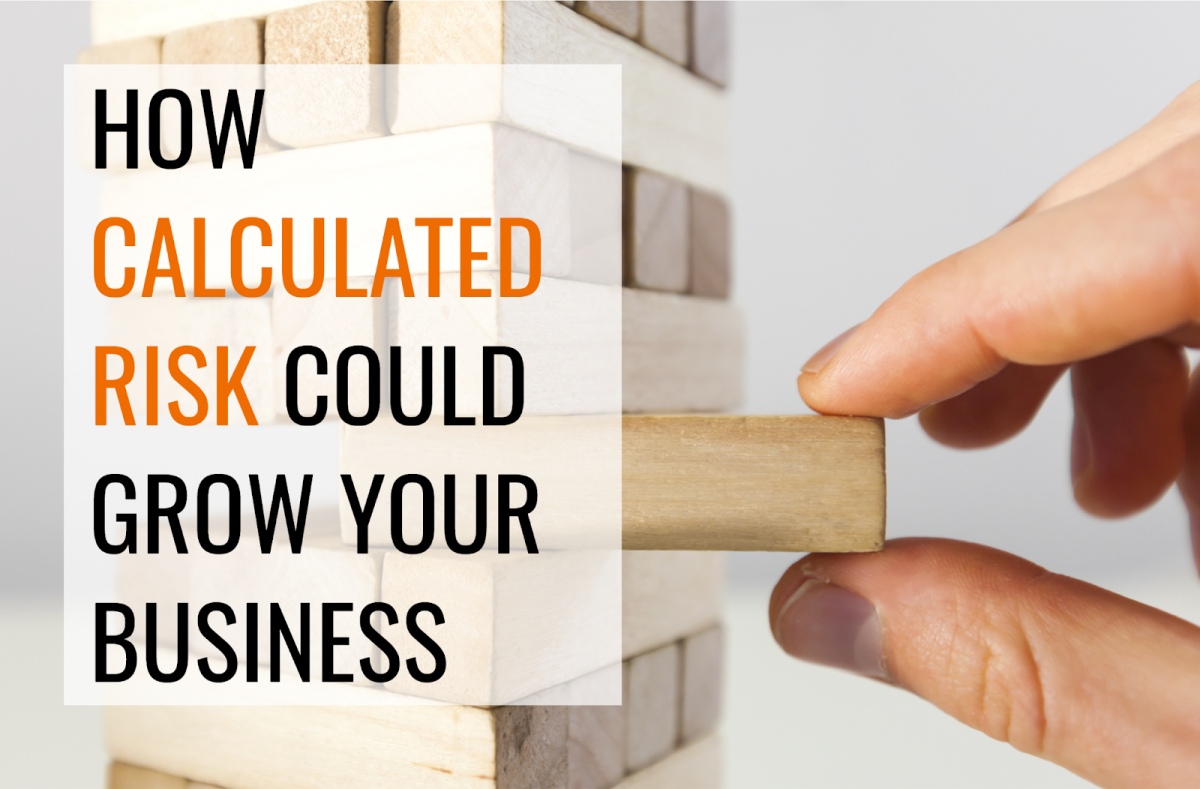When you hear the word “entrepreneur,” what comes to mind?
Chances are, “risk-taker” is somewhere in that list.
The truth is, risk-taking is central to every entrepreneur’s journey, but that doesn’t mean that you should always dive into everything headfirst.
The secret to success is calculated risk-taking: being able to do a careful risk assessment, accurately calculating those risks so that you know when one’s worth taking, and finding ways to mitigate unnecessary risk.
Knowing when to take a risk, and most importantly, HOW to take those risks is a crucial part of every entrepreneur’s journey. With this in mind, let’s take a look at how taking calculated risks can help you to grow your business, and see how you can help to mitigate problems when you’re venturing out on a limb.
The Problem With Risk
Let’s just start by getting it out there. Risk-taking for the sake of risk alone is bad.
Many first-time entrepreneurs assume that reckless risk-taking is just part of the job, something they’ll need to do if they want to find success. This myth is perpetuated in many circles and among entrepreneurs, where we have a tendency to attribute our success directly to risk-taking while leaving out all of those other details –like calculating risk, assessing potential returns versus loss, and making informed decisions.
The result is that it paints a distorted picture of risk and reward, and leaves many would-be entrepreneurs feeling like in order to be successful they need to take reckless risks –which certainly isn’t the case.
Open risk-taking is similar to a game of roulette; you throw the dice and hope for the best. There’s not much skill, strategy, planning, or calculation involved with these types of risks, and these risks are not the best strategy in business.
The best approach?
Taking calculated risks. A risk where you’ve considered the odds, and you KNOW that you have a good chance of being successful. It’s also about ensuring that the rewards are greater than the potential losses, and then looking to mitigate those risks as much as possible.
When Risk-Taking Can Be a Good Thing
Now, a look at some of the benefits of risks.
You know the adage, nothing ventured, nothing gained? Well, it often rings true. Play it too safe, and you’ll risk (no pun intended) missing out on higher returns.
Here are some reasons why risk-taking can be good.
It Leads to Innovation Opportunities
Risk is what leads to innovation. Innovation is created when a problem is identified and a person decides to make a leap with how to solve it in a way that’s never been done before. This can’t be done without some level of risk.
Author and Speaker Chuck Swoboda states in his Forbes article, “Akin to investing in the stock market, innovation is intrinsically tied to risk; if you want a bigger return, you have to take on more risk.”
If you are going to create something new, exciting, and innovative in your industry, you’ve got to be crazy enough to risk it. Think of Amazon, Google, Apple, and many, many other companies –they were all born out of risk.
It’s a Great Learning Opportunity
I know, I know, no one wants to learn expensive lessons. But sometimes, those costly lessons can teach us exactly what we need to know in order to advance further.
Consider how the Australian Institute of Business puts it. They state that you’ll never know if something works until you try it, and you have no way of advancing your business if you just sit stagnant. They use the analogy of, “You can’t steal second base if you keep your foot on first.” Learning is what leads you to success, while a fear of failure (and risks) can stop you from progressing.
Get our How Risk-Taking Could Grow Your Business - Worksheet delivered right to your inbox.
Unexpected Growth Opportunities
Often, risk is directly connected to opportunity. You never know when your ability to quickly calculate risk and make decisions will lead you in a direction that opens doors to new opportunities. Perhaps a sudden idea or decision led to an influx of customers.
Or maybe you formed a partnership with a brand that aligns to your vision and created a bold new idea together. Your ability to pivot with change when things are difficult is what leads to more doors being opened for you in the long run.
You will only know if a decision will pay off once you’ve followed through with it, and that one decision could be the changing point for your entire business.
Satisfaction
Believe it or not, science indicates that people who take risks are more satisfied with their lives. The correlation between the fearlessness of taking risks, the lack of regrets over decisions that haven’t been made (nothing plagues an entrepreneur more than the dreaded, “What if?”), and the ability to shape your business in an innovative, impactful, and different way can be tremendously satisfying.
Using Idea Validation Framework to See Whether an Idea is Worth Pursuing
Okay, so you want to assess risk. Start by assessing the value of your idea.
When you have a big decision to make, try to assign a value to it based upon the following: how many resources do we already have, how many resources do we need to source, what’s the estimated cost to implement this, and how much time will it take to implement it. Finally, try to calculate your estimated return on investment.
Carefully consider what you stand to gain if you’re successful. You’ll want to make sure the level of risk that you’re taking on is commensurate with the potential rewards. Next, assess your likelihood of success. The last thing you’d want to do is take on a great deal of risk just to attempt to find something that will stick.
The answers to all of these questions will give you a good idea about whether an opportunity is worth pursuing any further. It’s all about your projected returns, in light of how much it will cost.
Now, just another quick note. Calculated risk does not mean you know every single possible outcome and the exact percentage of probability for that outcome, it just means you’re playing a hand of strategized blackjack rather than a game of chance at roulette.
While you don’t know for certain what will happen there’s a great deal of skill involved and if you play your cards right, you will stand a chance.
Chris Carosa, a senior contributor at Forbes describes the “Risk-Return Tradeoff” in his article: Why Successful Entrepreneurs Need To Be Calculated Risk Takers. He uses the example of running across a busy interstate; would you do it for a dollar? No. But for a million dollars, you might reconsider. Calculated risk works in the same way.
“Entrepreneurs make decisions just like stock investors,” he writes. “The only difference is entrepreneurs invest in their own businesses, while stock investors invest in other people’s companies.”
Entrepreneurs deal with incomplete information all the time and need to take calculated risks. But the secret to success is being able to mitigate those risks. “Simply coming up with a random idea and using other people’s money recklessly contributes to 90% of failed start-ups,” explains Carosa.
The concept of statistical significance comes into play here. You need to have enough data to make a decision – you don’t have all the information, but you have enough to move forward.
Mitigating Risks
Next, find out if there’s a way to mitigate some of that risk. Is there anyone else with experience in this area that you could bring on board? Could you conduct surveys to ensure that there’s market demand? What about testing the waters first with a small amount of stock, rather than buying 10,000 units?
Often, there are things that you can do to lower the level of risk involved, allowing you to move forward in a safer manner. Sure, risk-taking is part of being an entrepreneur, but success is all about making careful, fact-based decisions, not rushing forward recklessly when common sense is telling you to stay put.
You also need to give yourself permission to fail fast. This means moving and trying things, to quickly see what works, and what doesn’t. It means making micro-decisions, assessing, and then pivoting –rather than waiting for something to be perfect.
Having an MVP (minimum viable product) is best. There’s no need to add all the bells and whistles straight out of the gate. Get your basics right, test the waters, and see whether you’re on the right track.
It’s also important to gather as much data as you can upfront to lower unnecessary risk. Again, successful risk-taking isn’t about flying by the seat of your pants, or ignoring the data while simply willing everything to be alright.
Instead, it’s about taking the time to mitigate unnecessary risk by doing your research up front. Test those hunches, do market research, conduct surveys (actual surveys, not just conversations with friends), and then take a step out and try it.
At the end of the day, you need to work with what you have. Don’t be paralyzed by fear, but at the same time make sure you do your research first with the goal of assessing the market and ensuring that you put your best foot forward. It’s all about careful strategizing, so take the time to gather the data that you need or enlist the help that you require before you move forward.
When Risk Paid Off: Business Success Stories
It can’t be denied that risk-taking has led to some tremendous payoffs for many entrepreneurs and businesses. Here are a few examples of winning companies that involved making risky decisions.
Twitter: Did you know that Twitter rejected a $500 million dollar offer from Facebook at a time when it wasn’t generating extensive profits? Talk about a risky decision! Twitter now has an evaluation of $35 billion dollars. It clearly paid off.
Amazon: Amazon was founded as a way to make a more convenient platform for book sales. Bezos started this business out of his garage and took a risk. Bezos stated, “For me, I had to project myself forward to age 80. I don’t want to be 80 years old, cataloging a bunch of major regrets of my life.”
Huffington Post: The founder of Huffington Post, Arianna Huffington, wanted to create a new media platform and even faced the wrath of many naysayers for her grand idea. Now, it’s a successful online news publication.
If you want to read about more risk-taking success stories, check out Inc.’s Businesses That Took Huge Risks That Paid Off and 5 Wildly Successful Entrepreneurs Reveal How Risk Taking Propelled Their Careers.
It’s clear that calculated risk is the appropriate business decision for many entrepreneurs. The innovation, growth opportunities, learning, potential for outstanding success, and – of course – the happiness that risk brings make the probability of these decisions worth it.
No decision is foolproof, and without some level of risk, you’re going to stagnate. Instead of fearing risk, learn to work with it. Calculate what you stand to lose versus what you stand to gain, the likelihood of success, to ensure it’s a risk that’s worth taking.
Then get to work finding ways to mitigate some of that risk. Fear and an inability to move forward are the beginning of the end for any small business. The only way to progress is to begin with that first step, even when taking that first step involves a certain level of risk. With careful planning, and making sure you take steps to reduce unnecessary risk, you’ll be able to hedge your bets carefully, and find the safest course of action to reach your goal.
Are you looking for help scaling your business? I help business owners to grow by highlighting opportunities and strategies that they can use to ramp up their marketing strategies –draw in more customers, and close more sales. Reach out today for yourfree 20-minute consultation. Let’s find a solution that will help you to scale –and fast.
Get our How Risk-Taking Could Grow Your Business - Worksheet delivered right to your inbox.







